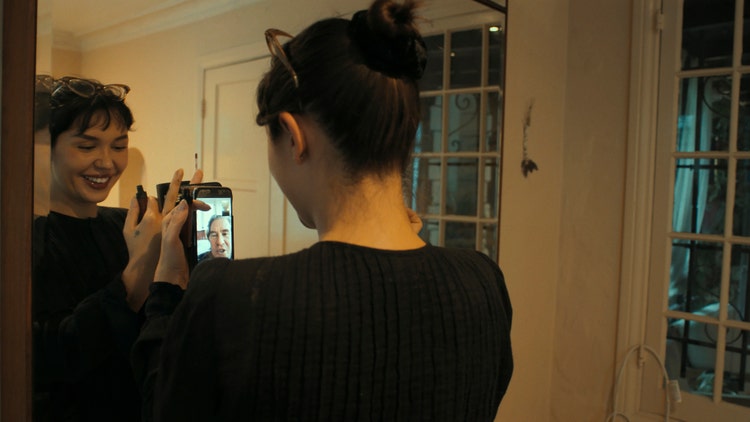An intimate look at the life and career of Actor Val Kilmer

Image source: Amazon Studios.
Nominated for Best Edited Documentary (Feature) at the 2022 ACE Eddie Awards, co-director and co-editors Ting Poo and Leo Scott created the feature film, Val, which centers on the daily life of actor Val Kilmer and features never-before-seen footage spanning 40 years. The raw and original documentary includes film and video footage that Val has been documenting of his own life, from 16mm home movies made with his brothers to time spent in iconic roles for blockbuster movies like Top Gun, The Doors, Tombstone, and Batman Forever.
We went behind the scenes of the Eddie-nominated documentary with Poo to learn how she and her team pieced together thousands of hours of footage using Premiere Pro, Frame.io, After Effects, and Photoshop.
How and where did you first learn to edit?
I started learning as an undergrad at Columbia University. I started on 3/4-inch tape reel to reel and then a Steenbeck. They also taught Adobe Premiere Pro (a very early version) at Columbia. More than 20 years later, I’m still learning.
How do you begin a project and set up your workspace?
I pretty much have a template that I use and adapt for every project that organizes cuts, media, selects, etc. I’ve been lucky in the last few years to have some amazing assistants who organize things better than I would do on my own, and I’m grateful.

Caption: Source: Amazon Studios.
Tell us about a favorite scene or moment from this project and why it stands out to you.
I chose the scene where Val goes back to Arizona after his mom passes away. To me, it exemplifies so many things I love about documentaries and the magical discoveries that are possible. Val shot the footage himself, and when I saw it I immediately recognized his mom’s house from footage shot 30 years prior. It’s a discovery you can only make as an editor because within hundreds of hours of footage, you recall the same feeling more than 30 years apart and see an opportunity to bring these two moments together to connect an emotion across time and space.
What were some specific post-production challenges you faced that were unique to your project? How did you go about solving them?
We had almost 20 different formats and over 1,000 hours of footage. Tracking down the machines to digitize all of it wasn’t easy let alone managing all the media. We found a lot of things on eBay. At one point, we bought medical-grade VHS decks because they were the only ones that would play back some of our tapes without tracking issues.

Image source: Amazon Studios.
What Adobe tools did you use on this project and why did you originally choose them? Why were they the best choice for this project?
We used Adobe Creative Cloud in its entirety. We edited the whole thing on Premiere Pro, used Photoshop to help create our titles and graphics, and occasionally used After Effects for simple compositing and cleanup. I also used the Warp Stabilizer tool a lot within Premiere Pro to smooth out a lot of the handheld footage.
How did Frame.io fit in as part of your workflow?
We used it at the end. Our color house was testing a beta version of it I believe and using it for reviews. I found it easy to use and particularly like the commenting tools.
How does Premiere Pro help your editing process?
Working in Premiere Pro (as opposed to other programs) feels more like painting or sculpting to me. It is so easy to grab different elements/formats/media and put them together. There’s a lot more freedom to edit horizontally and vertically, which is good because my mind tends to think in both directions.
What’s your favorite ‘hidden gem’ about using Adobe Creative Cloud?
It’s not hidden, but I use the markers all the time in Premiere Pro, especially in my timeline. I like pulling the banners out, so I can make notes and categories and have them visually represented on the screen. It saves a ton of time and when you have a feature length film, it provides a color-coded visual representation of that film.
Who is your creative inspiration and why?
I take most of my creative inspiration from music and art. When I’m trying to pinpoint a tone for a scene, I always look for a song — not necessarily to put in the scene but to nail down a specific feeling.
What’s the toughest thing you’ve had to face in your career and how did you overcome it? What advice do you have for aspiring filmmakers or content creators?
I think people always try and put you in a box at every stage in your career really. It’s not necessarily malicious, it’s a way of evaluating whether you’re “right” for something or not. All you can do is follow your interest. What is it about humans and our strange existence that is fascinating to you? If you can pull that out of everything you work on, big or small, you don’t need to worry about much else. Also, work your ass off.
What does your workspace look like?

Image source: Ting Poo.
Val is currently streaming on Amazon Prime Video.